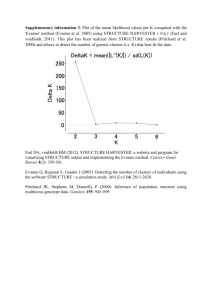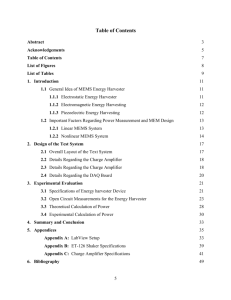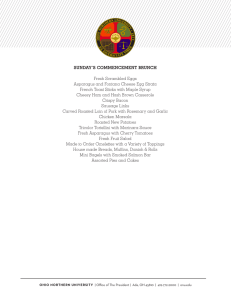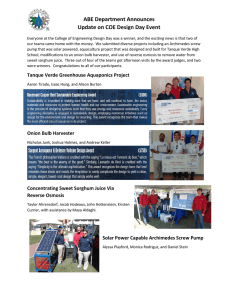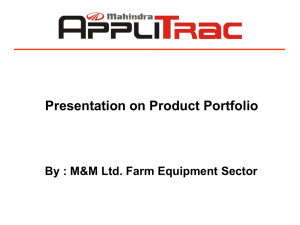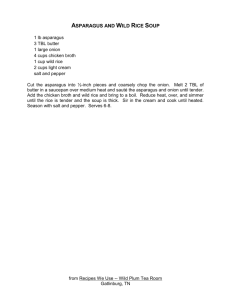Final Report Asparagus Harvester Trials Geiger Lund Selective Harvester Evaluation 2004-2005
advertisement
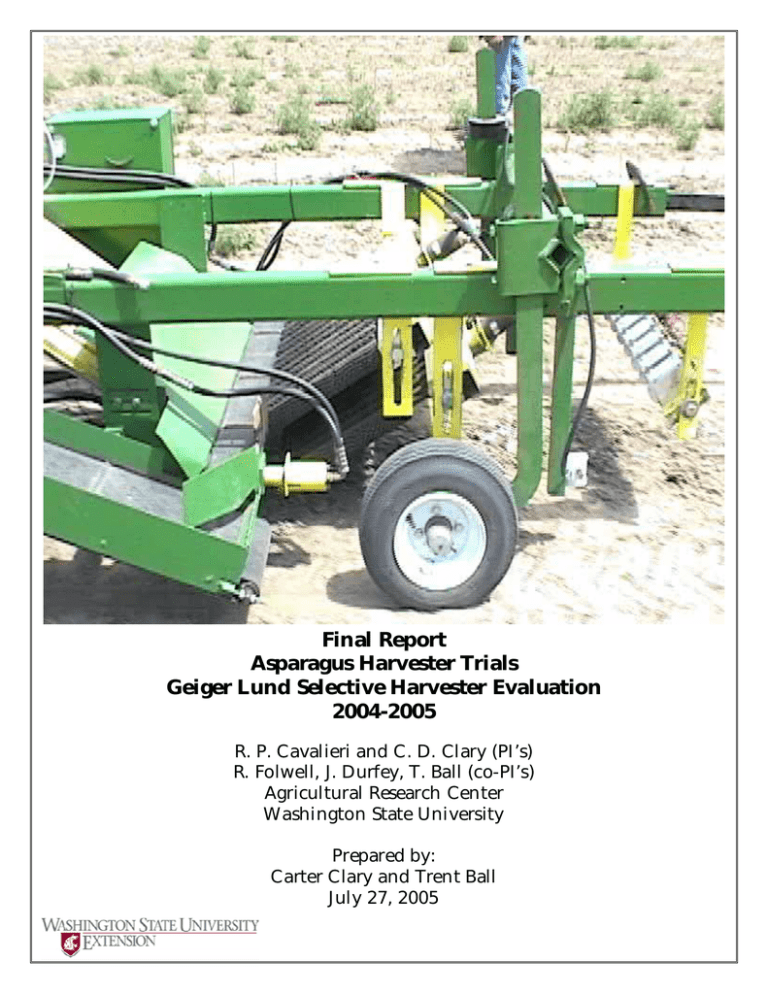
Final Report Asparagus Harvester Trials Geiger Lund Selective Harvester Evaluation 2004-2005 R. P. Cavalieri and C. D. Clary (PI’s) R. Folwell, J. Durfey, T. Ball (co-PI’s) Agricultural Research Center Washington State University Prepared by: Carter Clary and Trent Ball July 27, 2005 Final Report Asparagus Harvester Trials Geiger Lund Selective Harvester Evaluation 2004-2005 R. P. Cavalieri and C. D. Clary (PI’s) R. Folwell, J. Durfey, T. Ball (co-PI’s) Agricultural Research Center Washington State University Prepared by: Carter Clary and Trent Ball July 27, 2005 Opening Summary During the 2005 Washington asparagus harvest, a single row asparagus harvester prototype developed by Geiger Lund Harvesters, Stockton, CA was evaluated in the Pasco/Mesa area. Previous economic analysis indicated that a three row Geiger Lund harvester must recover 70% of hand harvested yield to be viable or recover 65% for a four row harvester. An evaluation was conducted to compare the selective harvester with a hand crew to analyze the machines efficiency. Eighteen rows were randomized between hand and machine treatments, with each treatment harvesting nine 1,150 foot rows. Each day, asparagus collected from each of the 18 plots was quantified and graded. The cullage, shorts and usable product were weighed. The hand harvested product and the machine usable product was then graded based on Washington fresh market standards. The total pay weight for the selective machine harvester was compared to the manual cutter to determine the efficiency of machine versus hand. In the Pasco, 2005 trials, the selective machine harvester demonstrated the highest efficiency ever achieved compared to hand on the first day of harvesting. This was followed by a decline in efficiency in subsequent days. Typically, the machine could harvest at least 74% of a hand crew on a pay weight basis on the first day of operation. However efficiency would decline in subsequent days. This pattern of declining yield had not been seen in previous studies, suggesting variety may have an impact. Certain varieties, including the ones used in this study, tend to produce spears in tighter clusters and subject more immature spears (< 8 inches in height) to collateral damage from the blade when it cuts an adjacent 9 inch spear. Varieties that produce spears that emerge in a more spaced pattern may be more conducive to a machine harvester, such as the Jersey varieties. The harvester’s mechanical systems have been significantly improved and are now functional and reliable during longer term operation. Problems identified in the Pasco, 2005 evaluation were not found in previous trials because we could never get past the breakdowns. The declining efficiency should be the focus of additional research by Geiger Lund Harvesters, which should examine narrower blades and the effects of field conditions and asparagus varieties. 1 BACKGROUND Developing and adopting harvesting systems for asparagus provides an important means to address increasingly urgent concerns including the rising cost of labor and global competition. These systems will help to maintain Washington State’s position in national and international markets. In addition to increases in the minimum wage to over $7/hr, changes in international trade policies have presented significant challenges to the asparagus industry in Washington State. The asparagus industry has been adversely impacted by imports from Peru. In addition to foreign competition, labor for hand harvesting asparagus has become scarce, particularly at the end of the season. It is common for fields to be abandoned prematurely due to lack of labor. This has prompted the industry to evaluate mechanical harvesting in order to reduce production costs associated with hand labor and extend the harvest window when hand labor is not available. During the 2004 Washington asparagus harvest, a single row asparagus harvester prototype developed by Geiger Lund Harvesters, Modesto, CA was evaluated in the Pasco/Mesa area. The harvester head employs parallel pairs of counter-rotating “brushes” that engage asparagus spears that have reached a specified height. As the machine moves down the row, the optical system senses a spear of the selected minimum height and actuates a cutting system that drives the closest blade into the soil at the base of the spear. The spear is pulled through counter-rotating brushes onto a back stop and conveyer that transports spears to the rear of the machine. Economic analysis indicates that a three row harvester must recover 70% of hand harvested yield to be viable. Experimental Design Methodology Plot Design Eighteen rows were randomized between hand and machine treatments, with each treatment harvesting nine 1,150 foot rows. The hand rows were manually cut and the product was put into bags for grading. A manual grader rode on the back of the harvester and sorted the product on the machine into three categories: (1) Usable undamaged product greater than 8 inches in length with at least 7 inches of green, (2) Usable undamaged product less than 8 inches (shorts), and (3) cullage, which includes debris, damaged product, seedy asparagus, etc. A researcher walked behind the machine and collected all the usable asparagus (>8 inches) that was dropped by the harvester. Collateral damage was counted as young emerging spears not yet of a usable length that were cut by the harvester and remained in the field. Grading Each day, asparagus collected from each of the 18 plots was quantified and graded. The cullage, shorts and usable product were weighed (Figure 1). The hand harvested product and the machine usable product was then graded based on Washington fresh market standards. 2 Figure 1. Breakdown of market grade, culls and dropped spears. RESULTS Several experiments were completed throughout the season. Changes in machine configuration did not allow for an extended statistical evaluation since each modification or improvement required the test plot be “re-set” by hand before the next trial could be initiated. In-row efficiency evaluation All asparagus product of appropriate height and diameter in the machine harvested rows was collected and categorized to determine the mass harvested, dropped, and missed by the selective machine. A crew followed behind the harvester to collect dropped and missed spears. Data were collected for three consecutive days. The results are presented in Table 1. Table 1. Total (100%) daily asparagus product available for harvest, by percentage Category Day 1 Day 2 Day 3 3-day Avg Net Weight Harvested 69% 67% 68% 68% Dropped Product 10% 13% 11% 11% Missed Product 21% 20% 21% 21% On average the machine harvested nearly 70% of the product that was of adequate height and diameter; dropped product accounted for 11%. During this trial, the machine was missing over 20% of spears in the field, which was due largely to early and side cuts (blade firing to the side of the spear). This analysis indicated the need to reduce the amount of side and early cuts to improve efficiency. Improving the pickup unit could reduce the amount of drops further increasing the ability of the mechanical harvester to obtain a higher percentage of available spears. The overlap among the sensors was increased to reduce the amount of missed product by sending two blades. Although this drastically reduced the amount of missed spears it increased the amount of collateral damage, reducing the yield for subsequent days. 3 Machine vs. Hand Yield The daily pay weight was calculated for the hand and machine harvested treatments. The total pay weight for the selective machine harvester was compared to the manual cutter to determine the efficiency of machine versus hand. Previous economic analysis for a three row machine has indicated that the machine must harvest 70% compared to a hand crew in order to be economically feasible. A four row machine must harvest 65% of a hand crew based on a 5,500 pound per acre yielding asparagus field. Breakdowns and performance related issues forced the trials to be stopped and restarted several times throughout the season. Typically, the machine could harvest 74% of a hand crew on a pay weight basis on the first day of operation. This pattern was seen on three separate occasions. The longest series of data collection occurred from June 5 to June 11, as presented in Figure 2. On the first day, the machine harvested 74% of the hand harvested yield. This declined to 43% on the second day because the asparagus was too short and the machine does not perform as well as a hand crew on slow growth days. Efficiency was 64% on the third day but declined steadily for the next three days. This indicates that the machine initially has the ability to cut a good percentage of the usable spears compared to a hand crew, but other factors caused the machine yield to decline relative to the hand yield. Several asparagus growers have suggested that variety has a significant impact on the performance of a machine harvester. Certain varieties, including the ones used in this study, tend to produce spears in tighter clusters and subject more immature spears (< 8 inches in height) to collateral damage from the blade when it cuts an adjacent 9 inch spear (Figure 3). Varieties that produce spears that emerge in a more spaced pattern such as the Jersey varieties may be more conducive to a machine harvester. 80% Percentage 70% 60% 50% 40% 30% 20% 10% 0% 6/5/05 6/6/05 6/7/05 6/8/05 Date 6/9/05 6/10/05 6/11/05 Figure 2. Percentage of pay weight harvested by the Geiger Lund Harvester compared to hand harvesting – Pasco, 2005. 4 Figure 3. Collateral Damage to Immature Spears. Trend Analysis In the Pasco, 2005 trials, the selective machine harvester demonstrated the highest efficiency ever achieved compared to hand on the first day of harvesting. This was followed by a decline in efficiency in subsequent days. A trend comparison was conducted with the current efficiency pattern for the selective harvester and recent trials (El Centro 2005 and Pasco 2004). In previous studies, the machine was not able to obtain an efficiency as good as Pasco 2005, but also did not exhibit a drastic decline in yield (Figure 4). Asparagus grades and dropped spears All product harvested by the machine was sorted on the back of the harvester to eliminate trash, damaged and seedy asparagus (culls). More than 70% of the sorted product was graded as usable spears, greater than 8 inches in length and more than 3/8 inches in diameter. By comparison, the manual harvester had an average grade of 87% usable spears. The difference can be attributed to the method of harvesting. The manual cutter does a “double cut” in the field to trim the ends of the harvested spears to fit in the box. The machine harvested product is delivered as it is cut in the field, with the butt ends attached. This is substantiated by the fact that the butts, trimmed portion of the asparagus to make a 9 or 8 inch spear, is 22% for the machine harvested product and only 11% for the manually harvested asparagus. 5 Pasco 04 El Centro Pasco 05 80% Machine vs Hand 70% 60% 50% 40% 30% 20% 10% 0% 1 2 3 4 5 6 7 Harv est Day Figure 4. Geiger Lund Selective harvester recovery at Pasco, 2004, El Centro, 2005 and Pasco, 2005. Dropped asparagus that was cut by the machine that did not make it onto the harvester was a significant limitation in the El Centro 2005 trials. Of the pay weight harvested, there was nearly 40% of usable dropped product in El Centro, while that number was only 16% in Pasco 2005. This improvement was due largely to the addition of a double roller system after the El Centro tests. Additional improvement is needed to reduce the number of dropped spears. Discussion Numerous improvements were made to the selective machine harvester for the Pasco 2005 trials. The two sets of rollers reduced drops, the reinforced cylinders and mounting brackets decreased breakdowns, conveyor systems eliminated damage, and timing of the cut was dramatically improved. Initial test days in a field with the machine would generate a machine versus hand efficiency above the economically acceptable point. However, in subsequent days the efficiency would decline. Collateral damage is likely the primary reason. It is possible that asparagus variety has a major impact on the harvester’s ability to compete with a manual cutter. Varieties with spears that do not emerge in clusters may be better. Narrower blades and more sensors may be a practical solution to reduce the amount of collateral damage. Further, having control of the bed height with gauge wheels in combination with sensing systems would alleviate problems. We observed that repeated passes by the machine created wheel furrows that do not track the asparagus bed soil height. By not having the header track the bed soil height, the spear height sensor is adversely affected. To compensate, Geiger Lund extended the stroke of the cylinder, which in turn caused more collateral damage. CONCLUSIONS The harvester’s mechanical systems were significantly improved and are now reliable during a longer term operation. Problems with field damage identified in the Pasco, 2005 evaluation were not found in previous trials because we could never get past the breakdowns. The declining harvester efficiency is of the greatest concern. If research is to continue with the Geiger Lund machine, the manufacturer should consider narrower blades, and the effect of 6 field conditions and asparagus varieties. Prior to a study next season, the asparagus field should be prepared for a mechanical harvester (leveling the field, weed control, turning space, etc.). It is as important to modify the field conditions to optimize machine performance based on a complete production system, such as has occurred in the grape industry with harvesters. Although the Geiger Lund harvester efficiency is not at the economically acceptable level over the multiple harvest days, there was significant progress made in the Pasco, 2005 trials. Harvester reliability has improved to the extent daily operation was possible without breakdowns. This is the result of three re-models of the machine in a one year period. We recommend continuing the development of the Geiger Lund harvester while consideration and testing should also be done on any other available selective harvester technologies. 7
